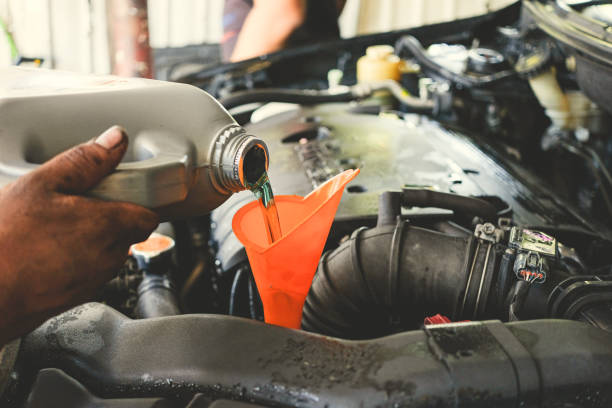CVT transmission isn’t a new technology in the advanced technology nowadays. With lots of benefits, the CVT is found in many Nissan, Honda, or Toyota models made in mass production. Like the other types of transmission, to keep your vehicle running smoothly, changing the transmission periodically is key when using a CVT transmission. Whether CVT fluid is the same as ATF fluid and how often to change CVT transmission fluid? Today, we will gather all the information related to this CVT fluid to give you a complete answer.
Contents
Is CVT Fluid The Same As Transmission Fluid?

Our answer is “No”. CVT transmissions use a special fluid specially designed for them. Although it has the same purpose of cooling and lubricating the transmission parts, the CVT fluid has a different formula to meet the specific requirements of this transmission system. The CVT fluid has different additives, base stocks, viscosities, friction coefficients, etc compared to other transmission fluids. The smell of CVT transmission fluid is similar to sulfur and often contains high extreme-pressure additives to support stronger transmission effects. CVT oil often has high viscosity to ensure smooth system performance and better protection of the transmission belt
Instead of minimizing the friction between gears for smooth shifting like in the automatic transmission, CVT fluid has more friction modifiers to allow the belt to grip the pulleys effectively while also lubricating. According to the manufacturers, CVT transmission requires this special fluid because of the higher pressures used in operation, special metal parts, and the need to prevent belt slippage. For identification purposes, the CVT fluid is colored green, and even a small tablespoon of regular red ATF fluid will cause severe damage to the CVT transmission.
We conclude that ATF (automatic transmission fluid) and CVT fluid can not be used interchangeably and they are different, each type of the fluid will have its properties. So it’s important to consult the owner’s manual or trusted mechanics to ensure you use the correct fluid for your car. If you are stuck in the middle of nowhere, and you are completely out of the transmission fluid, you can probably pour the ATF fluid into the CVT transmission to get your car to move. But when you go to a place where they can put the right fluid in, you should flush it immediately and have the CVT transmission fluid change.
>> Related post: What Are The Most Common CVT Transmission Problems?
How Often To Change CVT Transmission Fluid?

CVT fluid is used for lubrication, plays a role in preventing wear and protecting the parts inside the gearbox, and maintains the flow at a temperature within the allowable range, increasing the life of the parts and vehicle transmission. As you know, CTV fluid is very crucial in the CTV transmission system, so you need to change the transmission oil if you don’t want your car to have many problems. So when is it necessary to replace the CTV gearbox oil:
Compared to the ATF fluid, the CVT fluid is expected to have a longer lifespan. But to enhance your car’s performance and the CVT longevity, we recommend that the CVT fluid be changed every 30000 to 60000 miles depending on many factors. However, this is only a theoretical number, in reality, the CVT fluid change time will often fluctuate shorter or longer based on the vehicle’s driving environment. If your vehicle is driven in extreme weather, stop-and-go conditions, and other heavy driving conditions, a fluid replacement will need to be done more frequently.
It is necessary to check and change CTV oil regularly to keep your vehicle running well, increasing the life of the transmission as well as your vehicle.
If you have a background as a mechanic, you can also change the oil at home. You can go to a reputable distributor to buy oil and change it yourself. Before replacing the new CVT fluid, you need to pour out all the old oil because the old fluid contains a lot of residue.
>> Read more: How Often To Change Transmission Fluid?
How To Check The Color Of CVT Fluid?
Checking the color of the CVT oil is the simplest way that owners can do themselves to check the condition of the CVT transmission fluid. Step by step to check the color of CVT fluid include:
- Step 1: Park the car on a flat surface and keep the engine running.
- Step 2: Open the car’s hood.
- Step 3: Look for the oil pipe to the transmission – usually cars have a distinguishing sticker, if you can’t see the sticker, you can use the car’s owner’s manual.
- Step 4: Pull the oil dipstick out of the tube, and examine the condition and color of the oil on the stick. Or you can use a towel to wipe off excess oil on the stick. Then, put the stick back into the tube and lift it out again to check the condition of the fluid again.
Like other transmission fluids, if you see these colors below when checking the CVT fluid, you should replace it immediately:
- Dirty brown transmission fluid, accompanied by a burning smell, may be a sign that the vehicle’s CVT transmission fluid has burned and the vehicle needs to be checked immediately.
- If the oil is milky brown, this is a sign that the transmission oil is dirty because the coolant has leaked out, flowed in, and mixed with the oil, causing the lubricant to change.
- If the transmission fluid has foam or bubbles, it means your oil is too old or you are using the wrong type of oil, causing the engine to clog the transmission hole.
Watch more:
Final Thoughts
Car owners should pay attention to the condition of the CVT oil regularly and change the fluid periodically to ensure that the fluid always maintains its proper role in lubricating the engine system, helping your vehicle operate in the best condition. Especially, when choosing the CVT fluid, make sure you consider the car’s manual before buying.
Corresponding to each type of transmission, there will be corresponding types of lubricants and each car manufacturer will also have its regulations on strict parameters for the types of oils in the gearbox. With the role of lubricating the details inside the gearbox, CVT oil must have high viscosity, anti-foaming properties, etc. to help the gearbox operate at maximum capacity.



